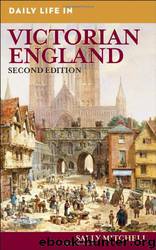Daily Life in Victorian England by Sally Mitchell

Author:Sally Mitchell [Mitchell, Sally]
Language: eng
Format: epub
Tags: History, Europe, Great Britain, Modern, 19th Century, Social History
ISBN: 9780313294679
Google: CsGKl5q-CMoC
Amazon: 0313350345
Publisher: Greenwood
Published: 1995-12-31T13:00:00+00:00
7 - FAMILY AND SOCIAL RITUALS
FAMILY AND PRIVATE LIFE
Family Roles and Relationships
The family—made up of a father, mother, and children living together—was increasingly idealized during the Victorian period. People developed firm ideas about how things ought to be, although not everyone could meet these standards. At the same time, real changes in work and income allowed family relationships to develop more fully. In the working class, growing prosperity allowed more space for shared activities and enabled childhood to last longer. Among aristocrats, extended families had formerly promoted economic and political interests rather than encouraging close affectionate ties. But with Queen Victoria, Prince Albert, and their nine children as models, the upper classes now paid more attention to family celebrations and to establishing a public image of closeness and intimacy.
The middle-class family in its private home was central to the new ideology. Middle-class houses were large enough for family activities yet too small for the separate smoking rooms, morning rooms, and children’s wings of aristocratic households. Middle-class women could focus their attention on family and children; they did not need to earn money (as did wives in the working class), nor did they have the social and political obligations of aristocratic women. The model of mother at home, father at work, and family as the center of children’s lives—the model taken as “natural” for much of the twentieth century—had its origin in middle-class patterns of life. During the nineteenth century, English middle-class households were less likely to include unrelated persons (except for servants), and grown children lived at home as long as they were single. An unmarried aunt or widowed grandmother might also be in the house.
Ideologically, the middle-class home and family represented the essence of morality, stability, and comfort. The husband had legal and economic control over his wife, children, and servants. The family depended on his income: the wife did not bring in money through labor (as in the working class) or have a private settlement (as among gentry and aristocrats). The children remained subordinate and obedient. Boys, who needed extended schooling to reproduce their parents’ style of life, were under their father’s authority until they had enough training and experience to make their own way in the world. Middle-class daughters were not expected to “make their own way”—with a very few exceptions, they stayed at home unless or until they married.
Families influenced one’s economic prospects as well as one’s affections. Many sons took up their father’s occupation. As apprenticeship grew less common in skilled trades, fathers and uncles became an important source of boys’ training. Kinship connections helped young men find positions in politics, foreign service, business, medicine, and the church. As late as the 1890s, 40 percent of all clergymen were the sons of clergy.
Extended families were still significant. Working-class girls in their early teens might become part of a married sister’s household to help with baby care. Middle-class girls were sent to live with cousins in the city as sister governesses. They helped teach the younger
Download
This site does not store any files on its server. We only index and link to content provided by other sites. Please contact the content providers to delete copyright contents if any and email us, we'll remove relevant links or contents immediately.
| Africa | Americas |
| Arctic & Antarctica | Asia |
| Australia & Oceania | Europe |
| Middle East | Russia |
| United States | World |
| Ancient Civilizations | Military |
| Historical Study & Educational Resources |
Room 212 by Kate Stewart(5035)
The Crown by Robert Lacey(4723)
Endurance: Shackleton's Incredible Voyage by Alfred Lansing(4676)
The Iron Duke by The Iron Duke(4291)
The Rape of Nanking by Iris Chang(4137)
Joan of Arc by Mary Gordon(4013)
Killing England by Bill O'Reilly(3951)
Say Nothing by Patrick Radden Keefe(3903)
I'll Give You the Sun by Jandy Nelson(3357)
Shadow of Night by Deborah Harkness(3302)
Hitler's Monsters by Eric Kurlander(3268)
Mary, Queen of Scots, and the Murder of Lord Darnley by Alison Weir(3148)
Blood and Sand by Alex Von Tunzelmann(3138)
Darkest Hour by Anthony McCarten(3070)
Eleanor & Park by Rainbow Rowell(3063)
Margaret Thatcher: The Autobiography by Thatcher Margaret(3028)
Red Famine: Stalin's War on Ukraine by Anne Applebaum(2873)
Book of Life by Deborah Harkness(2867)
The One Memory of Flora Banks by Emily Barr(2803)
